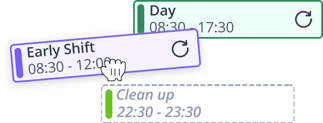In this guide, we’ll explore how self-scheduling empowers employees to take control of their shifts while helping managers streamline workforce management.
What is self-scheduling?
Often referred to as the cornerstone of a balanced life, self-scheduling empowers individuals to take control of their time like never before. This alternative to traditional scheduling processes introduces a dynamic system where employees have the autonomy to craft their own shifts.
It's a game-changer in industries like healthcare, where shifts are essential but often rigid. With self-scheduling, even the least popular or unfilled shifts can be managed effectively, ensuring smooth operations while giving workers the flexibility they need.
🪙 Key features of self-scheduling:
-
Employee-Driven: Staff choose their shifts within available slots.
-
Technology-Enhanced: Uses software or apps to streamline the process.
-
Dynamic: Adapts to changes, allowing shift swaps or adjustments.
-
Transparent: Everyone can see which shifts are filled or still open.
Who uses self-scheduling?
Self-scheduling is not just a fancy idea; it’s becoming the norm in industries where flexibility is key. Here’s a quick look at who’s jumping on the self-scheduling bandwagon:
| Industry | Typical Use Case | Examples |
|---|---|---|
| Healthcare | Managing rotating shifts and emergencies | Hospitals, clinics, care homes |
| Retail | Handling seasonal changes and peak hours | Shops, supermarkets, department stores |
| Hospitality | Covering unpredictable customer demand | Restaurants, hotels, event management |
| Manufacturing | Balancing production lines and maintenance | Factories, warehouses, assembly lines |
| Remote Work | Offering flexible hours for global teams | IT, customer support, marketing agencies |
How does it differ from traditional scheduling?
Self-scheduling is not just a trendy buzzword. It’s fundamentally different from the traditional approach where managers decide who works when. Here’s how they stack up:
| Aspect | Traditional Scheduling | Self-Scheduling |
|---|---|---|
| Control | Manager decides the shifts | Employees choose their own shifts |
| Flexibility | Low | High |
| Administrative Effort | High (manual planning) | Low (automated through software) |
| Employee Engagement | Limited (top-down approach) | High (employees involved) |
| Adapting to Changes | Difficult, time-consuming | Easy, real-time adjustments |
How does self-scheduling work?
The self-scheduling process is remarkably simple. Individuals are granted access to scheduling tools or software that facilitate the creation of their own shifts. This opens up a world of possibilities, enabling employees to balance their personal lives with work commitments seamlessly. Key components make this process successful:
-
Access to scheduling tools or software: Introducing self-scheduling solutions often comes with dedicated tools or software. These platforms provide a user-friendly interface enabling individuals to view available shifts, ensuring they can actively participate in the scheduling process.
-
Establishment of available time slots: In the self-scheduling framework, individuals can view open shifts and time slots, allowing them to choose the periods that align best with their shift preferences and availability.
-
Allocation of tasks or activities: With self-scheduling, employees can go beyond merely choosing shifts. They can also allocate specific tasks or activities to these shifts, optimising their efficiency and contributing to the organisation's productivity.
-
Flexibility and adaptability: Perhaps the most remarkable aspect of self-scheduling is its adaptability. Individuals can easily adjust their schedules to accommodate personal needs or unforeseen circumstances if life's unpredictability strikes. This flexibility ensures a better work-life balance and reduces stress associated with rigid schedules.
Benefits and challenges of self-scheduling
Self-scheduling might sound like a dream come true for employees, but it comes with its own set of perks and pitfalls. Let’s break down why it’s a game-changer, and where it can hit a few bumps.
✅ Benefits of self-scheduling
Self-scheduling isn’t just a buzzword; it brings real, tangible advantages to both employers and employees. Here’s why more businesses are giving it a go:
For employers:
-
Cost Efficiency:
Employees can pick up unpopular shifts voluntarily, reducing the need for expensive overtime or hiring temp staff.
👉 Example: In healthcare, where 24/7 coverage is essential, this can save thousands in labour costs. -
Improved Employee Morale:
Allowing staff to shape their own schedules shows trust and respect, boosting job satisfaction and reducing turnover.
👉 Example: A retail store saw a 20% drop in staff turnover after implementing self-scheduling. -
Streamlined Administration:
With the right software, managers spend less time manually creating rosters and more time on strategic tasks.
Useful Read: Excel + WhatsApp vs Shiftbase: The True Cost of Rotas, Time Edits and Payroll Errors
For employees:
-
Work-Life Balance:
Employees can align their shifts with personal commitments, reducing stress and burnout.
👉 Example: A parent can schedule shifts around school runs, leading to better engagement at work. -
Increased Autonomy:
Staff feel more in control, which can increase motivation and productivity. -
Flexibility in Shift Swapping:
If something unexpected pops up, workers can easily swap shifts with a colleague without manager intervention.
⚠️ Challenges of self-scheduling
Of course, self-scheduling isn’t perfect. Here’s what can go wrong if it’s not managed properly:
For employers:
-
Unfilled Shifts:
If everyone chooses the same time slots, less popular shifts might remain vacant.
✅ Solution: Set rules or incentives for picking less popular shifts. -
Scheduling Conflicts:
Without oversight, schedules can end up being uneven or unbalanced, affecting workflow.
👉 Example: During peak retail hours, insufficient coverage could impact customer service. -
Compliance Risks:
Different countries (like the UK and the US) have varying labour laws regarding working hours and shift notifications. Non-compliance can lead to legal troubles.
For employees:
-
Peer Pressure:
Some staff may feel pressured to pick less desirable shifts to maintain team harmony.
✅ Solution: Clear guidelines to ensure fairness and prevent resentment. -
Difficulty in Setting Boundaries:
Without clear policies, some employees might overcommit, leading to burnout.
👉 Example: Workers feeling the need to fill gaps constantly could harm their personal life.
🌐 Real-World Example: In a hospital setting, self-scheduling allowed nurses to choose shifts that fit their lives. However, it led to coverage issues during night shifts, forcing management to create a rule requiring equal rotation. Balancing autonomy with operational needs is essential.
How self-scheduling works for nursing
In healthcare, and especially in nursing, managing shifts can feel like solving a never-ending puzzle. Nurses need flexibility, but patient care can’t be compromised. Self-scheduling is becoming increasingly popular in healthcare settings because it balances staff autonomy with operational efficiency.
Let’s explore how self-scheduling works specifically for nurses, how to implement it effectively, and the best practices to make it successful.
The self-scheduling process for nurses
Self-scheduling allows nurses to select their shifts through an online platform, often integrated with the hospital’s HR system. This method contrasts with the traditional approach where managers assign shifts.
Here’s how it typically works:
-
Platform Access:
Nurses log into a scheduling platform (like Shiftbase) via mobile or desktop. -
Viewing Available Shifts:
The platform displays a calendar of open shifts, including night, weekend, and holiday slots. -
Selecting Preferred Shifts:
Nurses choose the shifts that fit their personal and professional needs, considering the unit’s coverage requirements. -
Approval and Confirmation:
A manager or automated system reviews the selections to ensure coverage and compliance with regulations (like rest periods and maximum hours). -
Shift Adjustment:
If a shift is overbooked or under booked, the platform may prompt staff to make adjustments or offer incentives for less popular shifts.
Implementation guidelines for healthcare settings
Implementing self-scheduling in a nursing environment requires careful planning. Here are the key steps:
1. Select the Right Software:
-
Choose a platform that supports healthcare-specific features, such as compliance checks and integration with payroll systems.
-
Look for real-time updates and mobile accessibility for nurses on the go.
-
Example: Shiftbase offers features like automated conflict resolution and secure data handling.
2. Establish Clear Guidelines:
-
Define which shifts are mandatory (e.g., weekends or night shifts) and ensure fair rotation.
-
Set boundaries on how far in advance shifts can be chosen or swapped.
-
Outline the process for resolving conflicts when too many choose the same shift.
3. Ensure Legal Compliance:
-
In the UK, ensure compliance with the Working Time Regulations 1998, which limit the number of hours worked and mandate rest breaks.
-
In the US, follow state-specific predictive scheduling laws, which often require advance notice for shift changes.
-
Implement a system for monitoring compliance automatically through the platform.
4. Pilot the System:
-
Start with one department or unit to see how self-scheduling affects workflow.
-
Gather feedback from nurses and managers to address any issues before a full rollout.
5. Training and Support:
-
Conduct hands-on workshops to familiarise nurses with the new system.
-
Offer continuous support through help desks or online tutorials.
6. Monitor and Optimise:
-
Regularly review how well self-scheduling meets staffing needs.
-
Adjust guidelines if specific shifts remain consistently unfilled.
-
Use analytics to track the impact on nurse satisfaction and patient care quality.
Useful Read: What’s The ROI of Rota Software? Savings, Benchmarks & Calculator
✅ Best practices for smooth implementation
To make self-scheduling work in a nursing environment, consider these tips:
-
Fairness First: Use a points-based system where nurses earn credits for working less desirable shifts.
-
Transparent Policies: Clearly communicate the rules for shift swapping and cancellations.
-
Incentivise Unpopular Shifts: Offer financial bonuses or additional days off for covering night or weekend shifts.
-
Monitor for Burnout: Keep an eye on staff who consistently pick up extra shifts to ensure they’re not overextending.


How Shiftbase supports self-scheduling
Implementing self-scheduling sounds great on paper, but making it work smoothly in practice can be a challenge—unless you’ve got the right tools. That’s where Shiftbase comes in. As a powerful SaaS for workforce management, Shiftbase takes the guesswork out of employee scheduling, time tracking, and absence management.
📅 Employee scheduling made easy
With Shiftbase’s employee scheduling feature, managers can set up flexible rosters while giving employees the freedom to pick their own shifts.
⏱️ Keep track of hours effortlessly
Tracking time is a breeze with Shiftbase’s time tracking tool. Employees can log their shifts, including start, break, and end times, all through a single platform. This ensures accurate records while reducing admin workload for managers.
🚫 Manage absences without the hassle
Absence management becomes a seamless part of the process with Shiftbase’s absence management feature. Whether it's planned leave or unexpected sick days, the system automatically updates the schedule, keeping the team in the loop and the roster balanced.
🚀 Ready to streamline your scheduling?
Take the stress out of managing shifts and let your employees take the wheel—with your guidance. Try Shiftbase for free for 14 days and see how easy self-scheduling can be. Start your free trial here!
Why wait? Give your team the freedom they want while keeping your business running smoothly.


